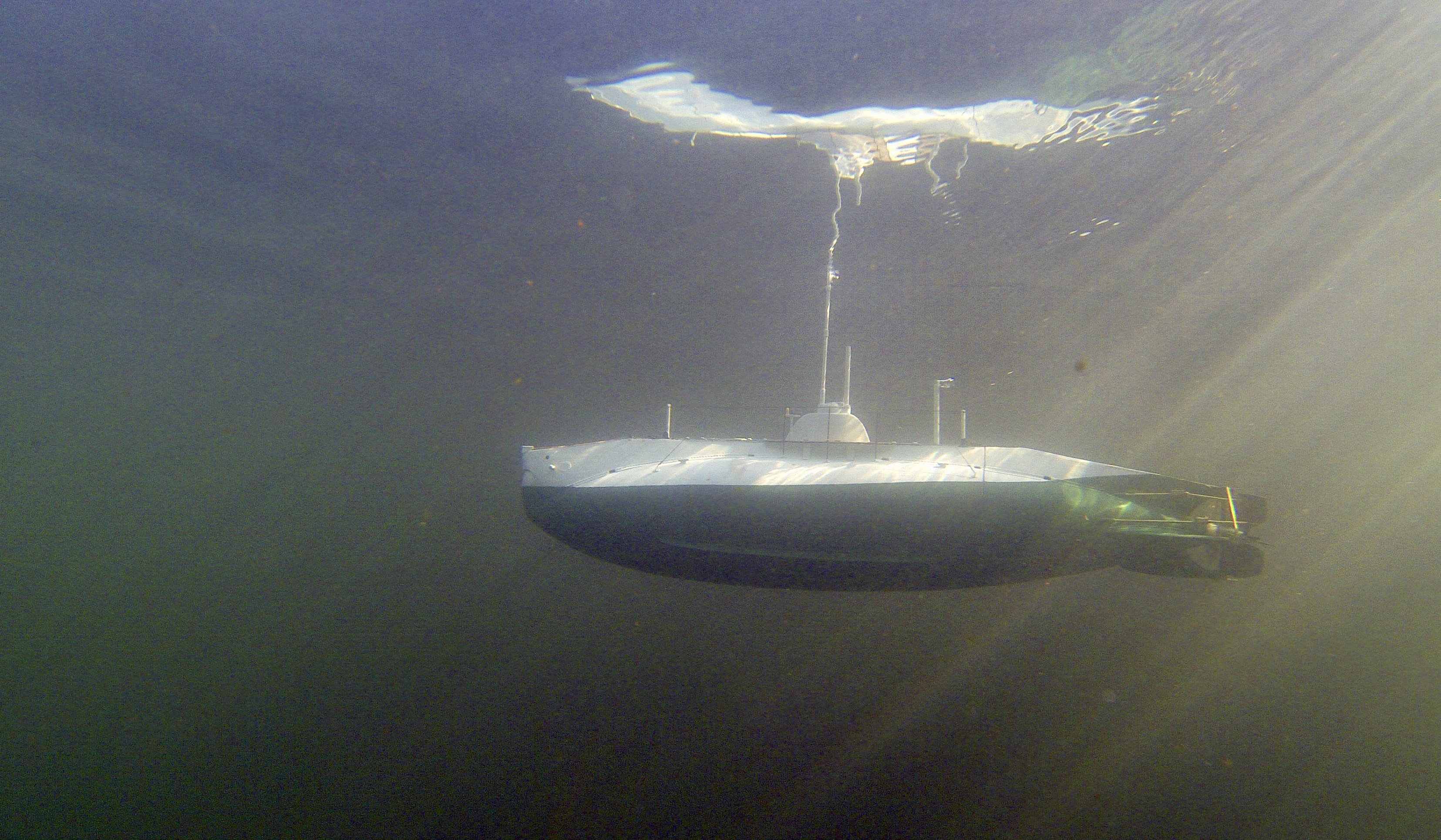Supplies of the Ship Modeler's Handbook are running out. Get your copy NOW before they are gone! Click on photo to order.
×
-
Posts
213 -
Joined
-
Last visited
Reputation Activity
-
 FreekS got a reaction from Rik Thistle in HrMs O-13 by FreekS - 1:50 - RADIO - 1931-1940 - Last Dutch Sub “on eternal patrol”
FreekS got a reaction from Rik Thistle in HrMs O-13 by FreekS - 1:50 - RADIO - 1931-1940 - Last Dutch Sub “on eternal patrol”
I’m just starting this new project. Netherlands started WW2 with 23 submarines, split evenly between Netherlands-based and Dutch East Indies based. Seven of these subs were lost. O-13 first saw action in the Spanish civil war escorting ships, and then escaped from Netherlands to England in May 1040 with many other boats. However, already in June 1940 on her second war patrol in the waters between Norway and Denmark she failed to return. To this day the wreck has not been found, but every few years there are searches with newer equipment. The most likely cause of her loss is being struck by a mine in a (now known) minefield along her route, but also attacks by German aircraft and a collision with a Polish sub are remote possibilities.
This model will be radio controlled, and the boat will be in-between my Holland-class O-1 (the first sub in the Dutch navy) and the larger K-XVIII which fought the Japanese in Asian waters. Both those models still sail regularly and well.
O-13 was part of a class of 4, at 60 meters in length and with underwater displacement of 750 tons she was suitable for coastal waters, but also travelled to the Dutch islands in the Caribbean and the waters around Gibraltar. She had 4 torpedo tubes in the bow, one in the stern, and two 40mm guns retracting into buns. No deck gun was installed and some of the 40mm guns were removed as the class had significant stability issues.
I have the original build plans (which can be downloaded freely from the Dutch national archives), but photos, especially dock-photos are relatively rare.
I plan to build a traditional plank on frame wooden hull, impregnated with epoxy and coated with woven glass. Inside will be a watertight compartment made up of several connected tubes to house the technology to fill and empty the dive tank, and to control the two props, rudder and diveplanes. I hope to include running lights in the wet area and also attempt to functionalisme the folding forward dive planes visible in the picture. Due to space constraints I will not aim to make moving periscopes and functioning torpedo’s for this model. In the end the model will be 120cm long, 13cm wide at its widest point, likely weigh 3-5kg, and use tubing of 50 and 75 mm diameter as water tight compartment.
So far, I’ve been doing rough planning of the location of components, closure means, and rough calculations of the required size of the dive tank to achieve a realistic waterline. I’ve also started to convert the build plans to individual frame drawings (taking into account the thickness of the hull planks (2mm) and the need to mount the frames on a build plank). Needless to say - this will not be a quick build!
-
 FreekS got a reaction from KeithAug in HrMs O-13 by FreekS - 1:50 - RADIO - 1931-1940 - Last Dutch Sub “on eternal patrol”
FreekS got a reaction from KeithAug in HrMs O-13 by FreekS - 1:50 - RADIO - 1931-1940 - Last Dutch Sub “on eternal patrol”
I’m just starting this new project. Netherlands started WW2 with 23 submarines, split evenly between Netherlands-based and Dutch East Indies based. Seven of these subs were lost. O-13 first saw action in the Spanish civil war escorting ships, and then escaped from Netherlands to England in May 1040 with many other boats. However, already in June 1940 on her second war patrol in the waters between Norway and Denmark she failed to return. To this day the wreck has not been found, but every few years there are searches with newer equipment. The most likely cause of her loss is being struck by a mine in a (now known) minefield along her route, but also attacks by German aircraft and a collision with a Polish sub are remote possibilities.
This model will be radio controlled, and the boat will be in-between my Holland-class O-1 (the first sub in the Dutch navy) and the larger K-XVIII which fought the Japanese in Asian waters. Both those models still sail regularly and well.
O-13 was part of a class of 4, at 60 meters in length and with underwater displacement of 750 tons she was suitable for coastal waters, but also travelled to the Dutch islands in the Caribbean and the waters around Gibraltar. She had 4 torpedo tubes in the bow, one in the stern, and two 40mm guns retracting into buns. No deck gun was installed and some of the 40mm guns were removed as the class had significant stability issues.
I have the original build plans (which can be downloaded freely from the Dutch national archives), but photos, especially dock-photos are relatively rare.
I plan to build a traditional plank on frame wooden hull, impregnated with epoxy and coated with woven glass. Inside will be a watertight compartment made up of several connected tubes to house the technology to fill and empty the dive tank, and to control the two props, rudder and diveplanes. I hope to include running lights in the wet area and also attempt to functionalisme the folding forward dive planes visible in the picture. Due to space constraints I will not aim to make moving periscopes and functioning torpedo’s for this model. In the end the model will be 120cm long, 13cm wide at its widest point, likely weigh 3-5kg, and use tubing of 50 and 75 mm diameter as water tight compartment.
So far, I’ve been doing rough planning of the location of components, closure means, and rough calculations of the required size of the dive tank to achieve a realistic waterline. I’ve also started to convert the build plans to individual frame drawings (taking into account the thickness of the hull planks (2mm) and the need to mount the frames on a build plank). Needless to say - this will not be a quick build!
-
 FreekS got a reaction from yvesvidal in HrMs O-13 by FreekS - 1:50 - RADIO - 1931-1940 - Last Dutch Sub “on eternal patrol”
FreekS got a reaction from yvesvidal in HrMs O-13 by FreekS - 1:50 - RADIO - 1931-1940 - Last Dutch Sub “on eternal patrol”
I’m just starting this new project. Netherlands started WW2 with 23 submarines, split evenly between Netherlands-based and Dutch East Indies based. Seven of these subs were lost. O-13 first saw action in the Spanish civil war escorting ships, and then escaped from Netherlands to England in May 1040 with many other boats. However, already in June 1940 on her second war patrol in the waters between Norway and Denmark she failed to return. To this day the wreck has not been found, but every few years there are searches with newer equipment. The most likely cause of her loss is being struck by a mine in a (now known) minefield along her route, but also attacks by German aircraft and a collision with a Polish sub are remote possibilities.
This model will be radio controlled, and the boat will be in-between my Holland-class O-1 (the first sub in the Dutch navy) and the larger K-XVIII which fought the Japanese in Asian waters. Both those models still sail regularly and well.
O-13 was part of a class of 4, at 60 meters in length and with underwater displacement of 750 tons she was suitable for coastal waters, but also travelled to the Dutch islands in the Caribbean and the waters around Gibraltar. She had 4 torpedo tubes in the bow, one in the stern, and two 40mm guns retracting into buns. No deck gun was installed and some of the 40mm guns were removed as the class had significant stability issues.
I have the original build plans (which can be downloaded freely from the Dutch national archives), but photos, especially dock-photos are relatively rare.
I plan to build a traditional plank on frame wooden hull, impregnated with epoxy and coated with woven glass. Inside will be a watertight compartment made up of several connected tubes to house the technology to fill and empty the dive tank, and to control the two props, rudder and diveplanes. I hope to include running lights in the wet area and also attempt to functionalisme the folding forward dive planes visible in the picture. Due to space constraints I will not aim to make moving periscopes and functioning torpedo’s for this model. In the end the model will be 120cm long, 13cm wide at its widest point, likely weigh 3-5kg, and use tubing of 50 and 75 mm diameter as water tight compartment.
So far, I’ve been doing rough planning of the location of components, closure means, and rough calculations of the required size of the dive tank to achieve a realistic waterline. I’ve also started to convert the build plans to individual frame drawings (taking into account the thickness of the hull planks (2mm) and the need to mount the frames on a build plank). Needless to say - this will not be a quick build!
-
 FreekS got a reaction from mtaylor in HrMs O-13 by FreekS - 1:50 - RADIO - 1931-1940 - Last Dutch Sub “on eternal patrol”
FreekS got a reaction from mtaylor in HrMs O-13 by FreekS - 1:50 - RADIO - 1931-1940 - Last Dutch Sub “on eternal patrol”
I’m just starting this new project. Netherlands started WW2 with 23 submarines, split evenly between Netherlands-based and Dutch East Indies based. Seven of these subs were lost. O-13 first saw action in the Spanish civil war escorting ships, and then escaped from Netherlands to England in May 1040 with many other boats. However, already in June 1940 on her second war patrol in the waters between Norway and Denmark she failed to return. To this day the wreck has not been found, but every few years there are searches with newer equipment. The most likely cause of her loss is being struck by a mine in a (now known) minefield along her route, but also attacks by German aircraft and a collision with a Polish sub are remote possibilities.
This model will be radio controlled, and the boat will be in-between my Holland-class O-1 (the first sub in the Dutch navy) and the larger K-XVIII which fought the Japanese in Asian waters. Both those models still sail regularly and well.
O-13 was part of a class of 4, at 60 meters in length and with underwater displacement of 750 tons she was suitable for coastal waters, but also travelled to the Dutch islands in the Caribbean and the waters around Gibraltar. She had 4 torpedo tubes in the bow, one in the stern, and two 40mm guns retracting into buns. No deck gun was installed and some of the 40mm guns were removed as the class had significant stability issues.
I have the original build plans (which can be downloaded freely from the Dutch national archives), but photos, especially dock-photos are relatively rare.
I plan to build a traditional plank on frame wooden hull, impregnated with epoxy and coated with woven glass. Inside will be a watertight compartment made up of several connected tubes to house the technology to fill and empty the dive tank, and to control the two props, rudder and diveplanes. I hope to include running lights in the wet area and also attempt to functionalisme the folding forward dive planes visible in the picture. Due to space constraints I will not aim to make moving periscopes and functioning torpedo’s for this model. In the end the model will be 120cm long, 13cm wide at its widest point, likely weigh 3-5kg, and use tubing of 50 and 75 mm diameter as water tight compartment.
So far, I’ve been doing rough planning of the location of components, closure means, and rough calculations of the required size of the dive tank to achieve a realistic waterline. I’ve also started to convert the build plans to individual frame drawings (taking into account the thickness of the hull planks (2mm) and the need to mount the frames on a build plank). Needless to say - this will not be a quick build!
-
 FreekS got a reaction from Mike Y in HrMs O-13 by FreekS - 1:50 - RADIO - 1931-1940 - Last Dutch Sub “on eternal patrol”
FreekS got a reaction from Mike Y in HrMs O-13 by FreekS - 1:50 - RADIO - 1931-1940 - Last Dutch Sub “on eternal patrol”
I’m just starting this new project. Netherlands started WW2 with 23 submarines, split evenly between Netherlands-based and Dutch East Indies based. Seven of these subs were lost. O-13 first saw action in the Spanish civil war escorting ships, and then escaped from Netherlands to England in May 1040 with many other boats. However, already in June 1940 on her second war patrol in the waters between Norway and Denmark she failed to return. To this day the wreck has not been found, but every few years there are searches with newer equipment. The most likely cause of her loss is being struck by a mine in a (now known) minefield along her route, but also attacks by German aircraft and a collision with a Polish sub are remote possibilities.
This model will be radio controlled, and the boat will be in-between my Holland-class O-1 (the first sub in the Dutch navy) and the larger K-XVIII which fought the Japanese in Asian waters. Both those models still sail regularly and well.
O-13 was part of a class of 4, at 60 meters in length and with underwater displacement of 750 tons she was suitable for coastal waters, but also travelled to the Dutch islands in the Caribbean and the waters around Gibraltar. She had 4 torpedo tubes in the bow, one in the stern, and two 40mm guns retracting into buns. No deck gun was installed and some of the 40mm guns were removed as the class had significant stability issues.
I have the original build plans (which can be downloaded freely from the Dutch national archives), but photos, especially dock-photos are relatively rare.
I plan to build a traditional plank on frame wooden hull, impregnated with epoxy and coated with woven glass. Inside will be a watertight compartment made up of several connected tubes to house the technology to fill and empty the dive tank, and to control the two props, rudder and diveplanes. I hope to include running lights in the wet area and also attempt to functionalisme the folding forward dive planes visible in the picture. Due to space constraints I will not aim to make moving periscopes and functioning torpedo’s for this model. In the end the model will be 120cm long, 13cm wide at its widest point, likely weigh 3-5kg, and use tubing of 50 and 75 mm diameter as water tight compartment.
So far, I’ve been doing rough planning of the location of components, closure means, and rough calculations of the required size of the dive tank to achieve a realistic waterline. I’ve also started to convert the build plans to individual frame drawings (taking into account the thickness of the hull planks (2mm) and the need to mount the frames on a build plank). Needless to say - this will not be a quick build!
-
 FreekS reacted to torpedochief in USS ETHAN ALLEN (SSBN- 608) by torpedochief - FINISHED - RESTORATION
FreekS reacted to torpedochief in USS ETHAN ALLEN (SSBN- 608) by torpedochief - FINISHED - RESTORATION
Before President Kennedy approved operation "Frigate Bird," he wanted to be sure he understood exactly what the launching sub looked like. This model was built to show him the lead ship of the new ETHAN ALLEN class of SSBN.
Operation "Frigate Bird," would be the worlds first and only launching of a fully armed nuclear-tipped ballistic missile. Upon studying the model Kennedy decided he needed to see the ship in person. Due to his back injuries climbing the ladders into the ship was not an option. Electric Boat fabricated a special cage that lowered the President into the submarine. Kennedy approved the operation.
The launch went off as planned. The warhead detonated over the Pacific with a force 15 times greater than the weapon used on Hiroshima.
What happened to this model is really unknown. It appears that for security reasons at the time large portions of the interior were removed. Now that the class is no longer in commision and the technology is declassified I can rebuild the interior to what it should have looked like. However, I can still only do the unclassified version of the Engineering spaces. Even the Nautilus Engineering Spaces are still classified. The exterior will be detailed and repainted as it would have appeared in the 1960s.This model is almost 7 feet long!! This will be a fun project for SUBVETS and all who served on the nations SSBNs.
-
 FreekS reacted to Valeriy V in SS Blagoev ex-Songa 1921 by Valeriy V - FINISHED - scale 1:100 - Soviet Union
FreekS reacted to Valeriy V in SS Blagoev ex-Songa 1921 by Valeriy V - FINISHED - scale 1:100 - Soviet Union
Thanks Phil! Thanks to everyone who has been following my topic all year!
Happy New Year to all forum members. May all your wishes come true this year!
-
 FreekS reacted to Valeriy V in SS Blagoev ex-Songa 1921 by Valeriy V - FINISHED - scale 1:100 - Soviet Union
FreekS reacted to Valeriy V in SS Blagoev ex-Songa 1921 by Valeriy V - FINISHED - scale 1:100 - Soviet Union
Now everything is in its place.
-
 FreekS reacted to Valeriy V in SS Blagoev ex-Songa 1921 by Valeriy V - FINISHED - scale 1:100 - Soviet Union
FreekS reacted to Valeriy V in SS Blagoev ex-Songa 1921 by Valeriy V - FINISHED - scale 1:100 - Soviet Union
I greet everyone and congratulate you on the New Year and Christmas holidays!
In the meantime, until the New Year comes, you can make a few details for the model.
-
 FreekS got a reaction from Bildad in Corsaro 2 by FreekS - FINISHED - Corel - 1:24 - RADIO
FreekS got a reaction from Bildad in Corsaro 2 by FreekS - FINISHED - Corel - 1:24 - RADIO
Today there was some wind at my model sailing club in Netherlands. Not very much and the trees make voor quite variable wind, but I managed to get half an hour of relaxed sailing, learning how the boat reacts. Happy with the result!
-
 FreekS reacted to Valeriy V in Cyclone-Class Destroyer 1902 by Valeriy V - scale 1:45 - Russian Imperial Navy
FreekS reacted to Valeriy V in Cyclone-Class Destroyer 1902 by Valeriy V - scale 1:45 - Russian Imperial Navy
When soldering, I do not use wood. All parts are soldered from brass and on a brass frame.
-
 FreekS got a reaction from robert952 in Davit & Lifeboat c. 1950 by FreekS - ~1:10 - RADIO
FreekS got a reaction from robert952 in Davit & Lifeboat c. 1950 by FreekS - ~1:10 - RADIO
The propshaft has a proven simmerring seal. There is no evidence of a leak there. I do expect some leakage where the lines to the rudder go through the hull, especially with motor in reverse. But some grease keeps it out pretty well.
thanks for all the likes, I’m starting to think of the automation of the Davit now….!
-
 FreekS got a reaction from mtaylor in Davit & Lifeboat c. 1950 by FreekS - ~1:10 - RADIO
FreekS got a reaction from mtaylor in Davit & Lifeboat c. 1950 by FreekS - ~1:10 - RADIO
The propshaft has a proven simmerring seal. There is no evidence of a leak there. I do expect some leakage where the lines to the rudder go through the hull, especially with motor in reverse. But some grease keeps it out pretty well.
thanks for all the likes, I’m starting to think of the automation of the Davit now….!
-
 FreekS got a reaction from Bob Cleek in Davit & Lifeboat c. 1950 by FreekS - ~1:10 - RADIO
FreekS got a reaction from Bob Cleek in Davit & Lifeboat c. 1950 by FreekS - ~1:10 - RADIO
The propshaft has a proven simmerring seal. There is no evidence of a leak there. I do expect some leakage where the lines to the rudder go through the hull, especially with motor in reverse. But some grease keeps it out pretty well.
thanks for all the likes, I’m starting to think of the automation of the Davit now….!
-
 FreekS reacted to John Ruy in Corsaro II by John Ruy - FINISHED - Corel - 1:24 Scale
FreekS reacted to John Ruy in Corsaro II by John Ruy - FINISHED - Corel - 1:24 Scale
Missing details…
Oops… I forgot the Reefing Lines on the Main Sail. 🤨. This would have been a lot easier before the mounting of the sails.
Reefing Lines complete…
Also noticed that I hadn’t placed the Spinnaker Booms. 😜
Now I can say she is FINISHED! As long as I walk away now. Darn OCD. 🤣
-
 FreekS reacted to John Ruy in Corsaro II by John Ruy - FINISHED - Corel - 1:24 Scale
FreekS reacted to John Ruy in Corsaro II by John Ruy - FINISHED - Corel - 1:24 Scale
FINISHED!!!
Hoisted the Italian flag 🇮🇹 on the Mizzen Mast. She is done…
@rshousha Thank you Rick for the opportunity to complete this beauty.
Cheers 🍻
-
 FreekS reacted to John Ruy in Corsaro II by John Ruy - FINISHED - Corel - 1:24 Scale
FreekS reacted to John Ruy in Corsaro II by John Ruy - FINISHED - Corel - 1:24 Scale
Sails…
Steady as she goes…
Cheers 🍻
-
 FreekS reacted to John Ruy in Corsaro II by John Ruy - FINISHED - Corel - 1:24 Scale
FreekS reacted to John Ruy in Corsaro II by John Ruy - FINISHED - Corel - 1:24 Scale
I liked your build as well… I produced my own Decals. I can PM you with the MS Word file and the details. It turns out water slide decals are a lot easier to produce than I thought. If you want to PM your mailing address to me, I’ll mail you my extra copy.
John
This is the trim tape I used for the stripe.
-
 FreekS reacted to John Ruy in Corsaro II by John Ruy - FINISHED - Corel - 1:24 Scale
FreekS reacted to John Ruy in Corsaro II by John Ruy - FINISHED - Corel - 1:24 Scale
Main Boom Topping Lift…
I re-shaped the Spreaders and installed the upper shrouds.
Giant Shrouds re-installed. The Upper Shrouds are the turnbuckles placed between the Giant Shrouds.
Flying Shrouds (starboard)
Two more Flying Shrouds to complete on the Port side and she will be ready for Sails.
Cheers 🍻
-
 FreekS reacted to Valeriy V in Cyclone-Class Destroyer 1902 by Valeriy V - scale 1:45 - Russian Imperial Navy
FreekS reacted to Valeriy V in Cyclone-Class Destroyer 1902 by Valeriy V - scale 1:45 - Russian Imperial Navy
This year, divers discovered these three wrecks and brought many interesting details to the surface.
Here is a link to a story about these dives under water.
https://dzen.ru/a/ZHm0TXZUbFRN7DJO
-
 FreekS reacted to Valeriy V in Cyclone-Class Destroyer 1902 by Valeriy V - scale 1:45 - Russian Imperial Navy
FreekS reacted to Valeriy V in Cyclone-Class Destroyer 1902 by Valeriy V - scale 1:45 - Russian Imperial Navy
Yes, this is a small space, parts are produced here, and their assembly takes place in the next room and it is a little larger. But even on this table, models with a length of up to two meters are quite successfully placed.
-
 FreekS reacted to Valeriy V in Cyclone-Class Destroyer 1902 by Valeriy V - scale 1:45 - Russian Imperial Navy
FreekS reacted to Valeriy V in Cyclone-Class Destroyer 1902 by Valeriy V - scale 1:45 - Russian Imperial Navy
I remember your request.
Now you can take pictures as a destroyer has appeared for the entourage.
-
 FreekS got a reaction from robert952 in Davit & Lifeboat c. 1950 by FreekS - ~1:10 - RADIO
FreekS got a reaction from robert952 in Davit & Lifeboat c. 1950 by FreekS - ~1:10 - RADIO
sails well - steering ok, there was about 100ml water in the boat - so I’m doing some more epoxy treatment. Needs a crew though!
-
 FreekS got a reaction from ccoyle in Davit & Lifeboat c. 1950 by FreekS - ~1:10 - RADIO
FreekS got a reaction from ccoyle in Davit & Lifeboat c. 1950 by FreekS - ~1:10 - RADIO
Progress on the lifeboat continues. The electromagnets are installed under the decks - they can unfortunately not be covered with thin veneer as this reduces their force dramatically.
I did add some hardwood along the sides and used veneer on the decks. Cracks were finished with epoxy containing some hardwood sawdust.
inside the boat I used some lighter hardwood for the floor “racks” and the benches. Navigation lights from some brass tubing and these are always on while the white top light can be switched.
the magnets are rated for 2,5kg each (under ideal conditions) at 6V. I’m however driving them via a relais at 10v (3S LiFePo). They do get warm and I need to ensure they are not on too long. So I installed a blue LED in the dashboard to signify when the magnets are powered and the boat can be lifted by the davit. Here the boat is connected to the davit in its case.
and the magnets release when they are switched off.
boat is ready for first test tonight - then some more details can be added and I can start to think how to control the davit raising and lowering the boat from the transmitter - without losing sight of the fact that this davit design was manually operated and not powered.
-
 FreekS got a reaction from ccoyle in Davit & Lifeboat c. 1950 by FreekS - ~1:10 - RADIO
FreekS got a reaction from ccoyle in Davit & Lifeboat c. 1950 by FreekS - ~1:10 - RADIO
sails well - steering ok, there was about 100ml water in the boat - so I’m doing some more epoxy treatment. Needs a crew though!








